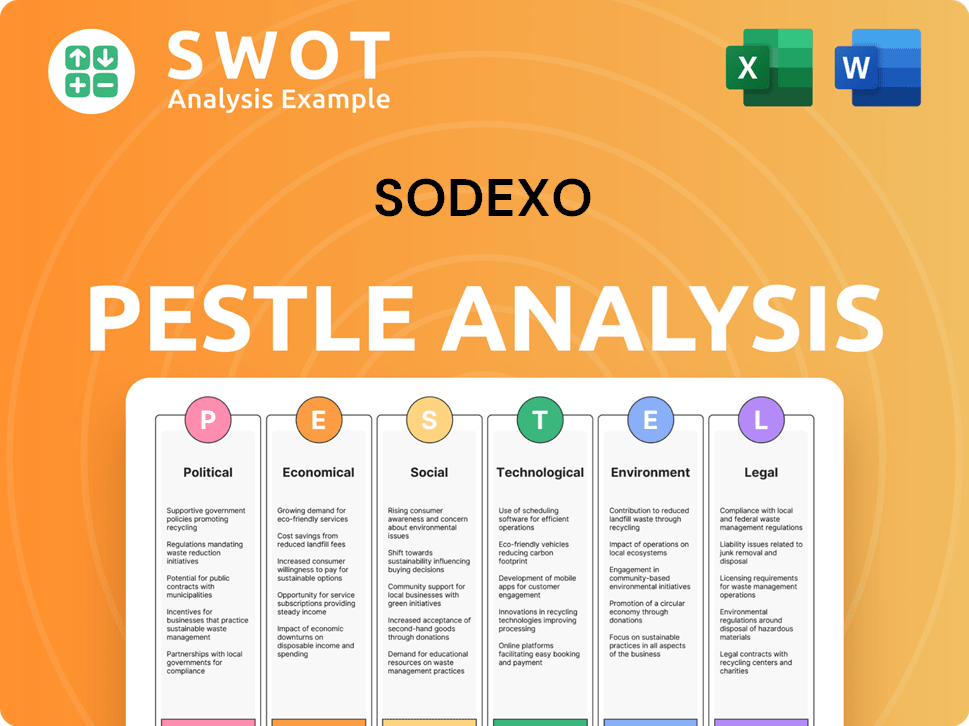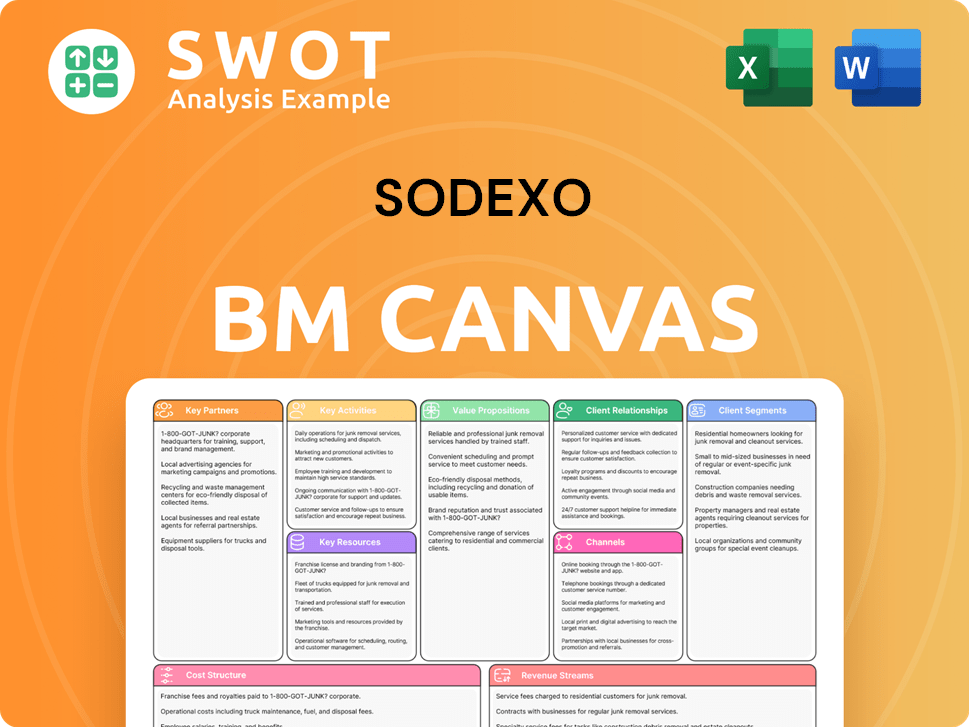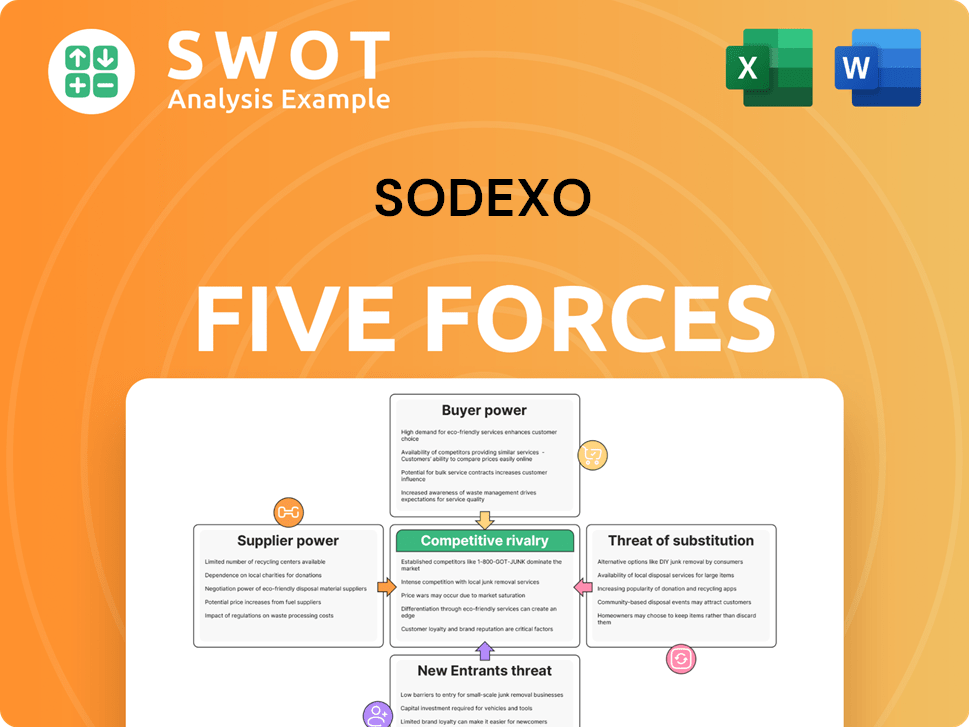Sodexo Bundle
How did Sodexo transform from a French startup to a global giant?
Ever wondered how a company can revolutionize the way we experience daily life, one meal or managed facility at a time? Sodexo, a name synonymous with Quality of Life Services, boasts a fascinating Sodexo SWOT Analysis, and a history of innovation. From its humble beginnings in 1966, this company has charted a course of remarkable growth. Discover the pivotal moments that shaped Sodexo's journey.

This brief history of Sodexo will unravel the Sodexo origins, tracing its evolution from providing catering in remote locations to becoming a global leader in integrated facilities management and Sodexo services. Explore the Sodexo company's strategic decisions and key milestones that propelled its expansion across 45 countries. Learn about Sodexo's impact on the industry and how it continues to shape the future of Quality of Life Services.
What is the Sodexo Founding Story?
The Sodexo company story begins on June 10, 1966, with the vision of Pierre Bellon. Bellon, a French entrepreneur, saw an opportunity to provide essential services to workers in remote locations. His understanding of the needs of workers in challenging environments laid the foundation for what Sodexo would become.
Bellon's initial focus was on addressing the lack of adequate living conditions and food services for employees in the offshore oil and gas industry. This early focus on worker well-being remains a core value for Sodexo. The company's early success was built on providing catering and hotel services to companies in remote areas.
The Sodexo history is marked by its commitment to improving the quality of life for workers. The company's initial business model centered on offering comprehensive services, including meals, cleaning, laundry, and maintenance, creating a 'home away from home'. The name 'Sodexo' is derived from 'Société d'Exploitation Hotelière,' reflecting its initial focus on hospitality management.
Sodexo was founded in 1966 by Pierre Bellon, addressing the needs of workers in remote locations.
- The initial focus was on catering and hotel services for the oil and gas industry.
- The company's early clients were in the Mediterranean region.
- The name "Sodexo" reflects its early hospitality focus.
- The company's early success was built on providing catering and hotel services to companies in remote areas.
The post-war economic climate in France and Europe provided a favorable environment for Sodexo's growth. The company's ability to support large-scale projects requiring remote operational support was a key factor in its early success. Initial funding likely came from Bellon's network, typical for a new venture in the mid-1960s. To learn more about the company's revenue streams and business model, you can read this article: Revenue Streams & Business Model of Sodexo.
Sodexo SWOT Analysis
- Complete SWOT Breakdown
- Fully Customizable
- Editable in Excel & Word
- Professional Formatting
- Investor-Ready Format

What Drove the Early Growth of Sodexo?
The early growth of the Sodexo company was marked by strategic expansion, both in its service offerings and geographical reach. Following its initial success in remote site services, Sodexo quickly diversified into other sectors. This included entering the corporate catering market, recognizing the need for quality food services in businesses. Internationalization was a key driver, with its first move into Belgium in 1971, followed by Africa.
The expansion of Sodexo began with its entry into Belgium in 1971. This was a pivotal moment in the Sodexo timeline, marking its first international venture outside of France. The company then expanded into Africa, showcasing its ability to manage complex logistics across diverse cultural and regulatory landscapes. This early internationalization laid the groundwork for its future global leadership.
Key acquisitions played a crucial role in Sodexo's early expansion. The acquisition of a majority stake in the American company Seiler's in 1975 was a monumental step. This entry into the North American market significantly broadened its operational scope. These strategic moves helped solidify Sodexo's position in the industry.
During this period, Sodexo introduced new services beyond food, such as facilities management, maintenance, and cleaning. This transformation evolved Sodexo into a more integrated service provider. The company began to offer a broader range of services to meet the evolving needs of its clients. This diversification was key to its growth.
The market reception to Sodexo's comprehensive service approach was largely positive. Companies increasingly sought outsourced solutions for non-core activities. Sodexo differentiated itself through its focus on quality of life, resonating with clients. By the end of the 1970s, Sodexo had established a significant presence across multiple continents.
Leadership transitions, with Pierre Bellon at the helm, focused on building a strong management team. The company's focus on quality of life resonated with clients looking to enhance employee well-being and productivity. For more information on the company's structure, you can read about Owners & Shareholders of Sodexo. By the end of the 1970s, Sodexo had established a significant presence across multiple continents, laying the groundwork for its future global leadership.
Sodexo PESTLE Analysis
- Covers All 6 PESTLE Categories
- No Research Needed – Save Hours of Work
- Built by Experts, Trusted by Consultants
- Instant Download, Ready to Use
- 100% Editable, Fully Customizable

What are the key Milestones in Sodexo history?
The Sodexo history reveals a journey marked by strategic growth and adaptation. From its Sodexo origins to its current global presence, the company has consistently evolved to meet changing market demands and client needs, establishing itself as a leader in integrated facilities management and food services.
| Year | Milestone |
|---|---|
| 1966 | Pierre Bellon founded the company in Marseille, France, initially focusing on providing food services to businesses. |
| 1970 | The company introduced 'Service Vouchers', revolutionizing employee benefits and expanding its market reach. |
| 1983 | Sodexo expanded internationally, marking the beginning of its global footprint. |
| 1996 | The company was listed on the Paris Stock Exchange, enhancing its financial capabilities and visibility. |
| 2000s | Sodexo expanded its service offerings to include integrated facilities management, broadening its scope. |
| 2020 | Sodexo adapted to the COVID-19 pandemic, pivoting to new service models such as delivering meals to healthcare workers and expanding personal and home services. |
Sodexo has consistently embraced innovation to stay ahead in the competitive market. This includes the development of healthy eating programs, sustainable sourcing initiatives, and personalized dining experiences to meet evolving consumer demands.
The introduction of service vouchers in 1970 provided a flexible and efficient way for companies to offer meal benefits, expanding the company's market reach. This was a groundbreaking innovation that set the stage for future growth and diversification.
Sodexo has launched programs focused on promoting healthy eating habits among its clients, reflecting a growing consumer interest in wellness. These programs often include nutritional information and customized meal options.
The company has implemented sustainable sourcing practices to reduce its environmental impact and support ethical business practices. This includes sourcing local and organic ingredients.
Sodexo has adopted smart building solutions and data analytics to optimize operational efficiency and reduce environmental impact in facilities management. This includes implementing energy-efficient systems and predictive maintenance.
Sodexo has focused on offering personalized dining experiences to meet the diverse preferences of its customers. This includes customized menus and dietary options.
The company is integrating technology to improve service delivery and customer experience. This includes using mobile apps for ordering and feedback, and implementing digital payment systems.
Throughout its history, Sodexo has faced various challenges that have shaped its strategies. Economic downturns, competitive pressures, and the COVID-19 pandemic have all tested the company's resilience and adaptability.
Economic fluctuations, such as the 2008 financial crisis, impacted client spending and required strategic adjustments. The company has had to manage costs and optimize operations during periods of economic uncertainty.
Competition from both global players and niche service providers has consistently pushed Sodexo to innovate and differentiate its offerings. The company continually seeks ways to enhance its services to remain competitive.
The COVID-19 pandemic significantly impacted the core food service business due to lockdowns and remote work. Sodexo responded by pivoting to new service models, such as delivering meals to healthcare workers and expanding personal and home services.
Managing a diverse global workforce and ensuring consistent service quality across different cultures has presented internal challenges. The company focuses on training and quality control to meet these challenges.
The company has undertaken restructuring efforts and rebranding initiatives to adapt to market changes and improve its competitive position. These efforts help to streamline operations and enhance brand identity.
Sodexo has increased its focus on a 'purpose-driven strategy,' emphasizing social and environmental responsibility. This reflects a broader industry trend towards sustainable business practices.
Sodexo Business Model Canvas
- Complete 9-Block Business Model Canvas
- Effortlessly Communicate Your Business Strategy
- Investor-Ready BMC Format
- 100% Editable and Customizable
- Clear and Structured Layout

What is the Timeline of Key Events for Sodexo?
Understanding the Sodexo history involves tracing its Sodexo origins and recognizing Sodexo's key milestones. This Sodexo company has a rich history marked by significant growth and adaptation in the services industry.
| Year | Key Event |
|---|---|
| 1966 | Pierre Bellon founded the company in Marseille, France, initially focusing on providing meals to businesses. |
| 1971 | The company expanded internationally, marking the beginning of its global presence. |
| 1983 | Sodexo went public, a significant step in its financial growth and expansion. |
| 1996 | Sodexo entered the North American market, increasing its global footprint and service offerings. |
| 2000s | The company expanded its services to include facilities management and other integrated services, diversifying its business model. |
| 2020 | Sodexo faced challenges due to the COVID-19 pandemic, which impacted its on-site services. The company adapted by focusing on hygiene and safety protocols. |
| 2023 | Sodexo reported revenues of €23.8 billion, demonstrating its continued market presence and recovery. |
Sodexo is increasingly emphasizing sustainability in its operations, with a focus on reducing its environmental impact. This includes initiatives to reduce food waste, promote sustainable sourcing, and lower carbon emissions. The company is setting targets to achieve net-zero carbon emissions by 2040.
Sodexo is investing in technology to improve its services, with digital solutions for food services, facilities management, and employee experience. This includes the use of data analytics to optimize operations, enhance customer experiences, and improve efficiency. Digital transformation is a key strategy for future growth.
Sodexo continues to expand its services and geographical reach, particularly in high-growth markets. This includes offering a broader range of integrated services to meet the evolving needs of its clients. The company is also exploring new business models and partnerships to drive growth.
With the changing nature of work, Sodexo is adapting its services to meet the needs of hybrid and remote work environments. This involves providing flexible food and facilities management solutions that support both on-site and remote employees. The company is focused on creating positive employee experiences.
To gain further insights into the competitive landscape, consider exploring the Competitors Landscape of Sodexo.
Sodexo Porter's Five Forces Analysis
- Covers All 5 Competitive Forces in Detail
- Structured for Consultants, Students, and Founders
- 100% Editable in Microsoft Word & Excel
- Instant Digital Download – Use Immediately
- Compatible with Mac & PC – Fully Unlocked

Related Blogs
- What is Competitive Landscape of Sodexo Company?
- What is Growth Strategy and Future Prospects of Sodexo Company?
- How Does Sodexo Company Work?
- What is Sales and Marketing Strategy of Sodexo Company?
- What is Brief History of Sodexo Company?
- Who Owns Sodexo Company?
- What is Customer Demographics and Target Market of Sodexo Company?
Disclaimer
All information, articles, and product details provided on this website are for general informational and educational purposes only. We do not claim any ownership over, nor do we intend to infringe upon, any trademarks, copyrights, logos, brand names, or other intellectual property mentioned or depicted on this site. Such intellectual property remains the property of its respective owners, and any references here are made solely for identification or informational purposes, without implying any affiliation, endorsement, or partnership.
We make no representations or warranties, express or implied, regarding the accuracy, completeness, or suitability of any content or products presented. Nothing on this website should be construed as legal, tax, investment, financial, medical, or other professional advice. In addition, no part of this site—including articles or product references—constitutes a solicitation, recommendation, endorsement, advertisement, or offer to buy or sell any securities, franchises, or other financial instruments, particularly in jurisdictions where such activity would be unlawful.
All content is of a general nature and may not address the specific circumstances of any individual or entity. It is not a substitute for professional advice or services. Any actions you take based on the information provided here are strictly at your own risk. You accept full responsibility for any decisions or outcomes arising from your use of this website and agree to release us from any liability in connection with your use of, or reliance upon, the content or products found herein.